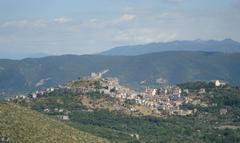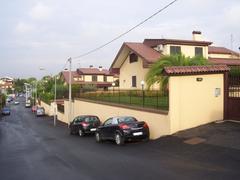Villanova Guidonia Montecelio Visiting Hours, Tickets, and Historical Sites Guide
Date: 15/06/2025
Introduction to Villanova Guidonia Montecelio and Its Historical Significance
Located just northeast of Rome in the province of Rome, Villanova di Guidonia Montecelio is a destination that seamlessly blends a rich historical heritage with vibrant contemporary life. As a district within the larger municipality of Guidonia Montecelio, Villanova offers an immersive experience that spans millennia—drawing visitors with its proximity to ancient Roman influences, UNESCO World Heritage sites such as Villa Adriana and Villa d’Este, lively festivals, and revitalized public spaces.
Villanova’s roots extend back thousands of years, with archaeological evidence revealing continuous human presence in the wider area. Its location near key Roman roads like Via Tiburtina and Via Nomentana facilitated trade and movement in antiquity (Latium Experience, Wikipedia). While Villanova itself does not contain major ancient remains, its vicinity to Villa Adriana—the imperial retreat of Emperor Hadrian—underscores its historical relevance.
Over the centuries, Villanova evolved from a medieval rural hamlet known as “Le Sprete” into a dynamic urban district. The 20th century brought significant change, notably with the establishment of a military airport and an aeronautical research center (Festa della Musica Italia, Wikipedia). Today, Villanova is both a thriving residential area and a cultural hub, offering sites like the Church of San Giuseppe Artigiano, vibrant markets, green parks such as Parco San Gabriele, and annual events like the Social Tour festival (RomaToday, Tiburno TV).
For those interested in history, the medieval Rocca di Guidonia fortress offers guided tours and panoramic views (Official Guidonia Montecelio Tourism Website). Villanova’s accessibility by bus and proximity to Rome make it a perfect base for discovering both local attractions and the greater Lazio region.
This guide provides detailed information on Villanova’s historical background, cultural highlights, visiting details (including tickets and opening hours), travel advice, and nearby attractions, ensuring a memorable and enriching experience for all visitors (Mapcarta, The Crazy Tourist).
Table of Contents
- Introduction
- Early Origins and Ancient Context
- Medieval and Early Modern Development
- Modern Era: Name, Growth, and Urbanization
- Demographic and Social Evolution
- Urban Structure and Cultural Landmarks
- Economic and Regional Significance
- Visiting Villanova: Practical Information
- Cultural Events and Social Engagement
- Parks and Green Spaces
- Historical and Cultural Sites
- Local Markets and Gastronomy
- Outdoor Activities and Sports
- Events and Community Life
- Accessibility and Visitor Tips
- Visiting Rocca di Guidonia
- FAQ
- Conclusion and Recommendations
- References
Early Origins and Ancient Context
Villanova is a populous district of Guidonia Montecelio, embedded in a region with at least 6,000 years of human activity (Latium Experience). Its strategic position near the Aniene River valley and ancient Roman roads like Via Tiburtina and Via Nomentana made it an important site for settlement and transit in antiquity (Wikipedia). While there is no direct evidence of a Roman urban center within Villanova itself, the area’s significance is highlighted by the nearby Villa Adriana, an imperial retreat reflecting the opulence and power of the Roman Empire (Mapcarta).
Medieval and Early Modern Development
The origins of present-day Villanova can be traced to the medieval hamlet “Le Sprete,” noted in 17th-century records, possibly named for its stony terrain (Diocesi Tivoli e Palestrina). In the Middle Ages, the region’s fortified settlements, especially Montecelio (founded as Castrum Monticellorum in 998), played a defensive role (Wikipedia). For centuries, Villanova remained a rural community under feudal and ecclesiastical control.
Modern Era: Name, Growth, and Urbanization
The district’s transformation accelerated in the 20th century. Until the 1960s, it was known as “Le Sprete,” later renamed “Villanova” to align with neighboring districts and reflect a modern identity (Festa della Musica Italia). The opening of the military airport “Alfredo Barbieri” in 1915 and the merger of Montecelio with the airport settlement in 1937—named Guidonia after aviation pioneer Alessandro Guidoni—catalyzed urban and economic growth (Wikipedia).
Demographic and Social Evolution
Villanova’s population grew rapidly after World War II, currently numbering around 23,000 (MOCADA). Its appeal lies in proximity to Rome, affordable housing, and expanding amenities. The community blends long-established families with newcomers, supported by educational institutions such as the Eduardo De Filippo schools (Festa della Musica Italia).
Urban Structure and Cultural Landmarks
The district’s layout centers on Via Maremmana, dividing the historic “Le Sprete” zone from newer districts. A key landmark is the Church of San Giuseppe Artigiano, built in the late 1950s and serving as a focal point for community life (Parrocchia San Giuseppe Artigiano). Villanova’s proximity to Hadrian’s Villa and Tivoli adds to its allure (Mapcarta).
Economic and Regional Significance
Villanova plays a significant role in Guidonia Montecelio’s industrial and service sectors, notably in travertine quarrying and cement production (The Crazy Tourist). Many residents commute to Rome, reflecting the district’s integration with the metropolitan economy (Wikipedia). Villanova’s community spirit is exemplified by events like Festa della Musica (Festa della Musica Italia).
Visiting Villanova: Practical Information
Visiting Hours and Tickets
- Villa Adriana (Hadrian’s Villa): Open daily from 9:00 AM to 7:30 PM (last entry 6:30 PM). Tickets: €10 for adults, discounts for EU citizens aged 18–25, free for under 18 (Villa Adriana Official Site).
- Villa d’Este: Open Tuesday–Sunday, 8:30 AM–7:30 PM (last entry 6:45 PM). Tickets: €13 for adults, with similar concessions (Villa d’Este Official Website).
- Church of San Giuseppe Artigiano: Open for services and events, generally mornings and evenings. No ticket required.
Accessibility and Travel Tips
- Regional buses connect Villanova to Rome and Tivoli.
- Driving: Convenient via Via Maremmana or Via Tiburtina, with parking near main sites.
- Best visiting seasons: Spring and autumn for pleasant weather.
- Guided tours: Available for Villa Adriana and local sites.
- Photography: The Via Maremmana and church are photogenic highlights.
Nearby Attractions
- Tivoli: Known for Villa d’Este and Villa Adriana.
- La Botte and Villalba: Neighboring areas with local markets and cuisine.
Cultural Events and Social Engagement
Villanova’s cultural calendar is anchored by the annual Social Tour festival, held in June, which transforms the district into a hub of music, art, and community engagement (Tiburno TV). Highlights include performances at Teatro Imperiale, public gatherings in Piazza Matteotti, and motor parades. Events emphasize social inclusion, are often free, and foster a lively communal atmosphere (RomaToday).
Parks and Green Spaces
- Parco San Gabriele: Recently revitalized, open daily 7:00 AM–9:00 PM, free entry (Tiburno, 2025).
- Parco Paolo Di Nella: In Villalba, temporarily closed for upgrades, reopening late 2025.
- Parco della Mezzaluna: In Colle Fiorito, open daily 7:00 AM–9:00 PM, free entry.
Historical and Cultural Sites
- Local churches: Offer insight into Villanova’s traditions, especially during religious festivals.
- Villa d’Este and Villa Adriana: Both UNESCO World Heritage Sites easily accessible from Villanova, with regular visiting hours and guided tours (Villa d’Este Official Website, Villa Adriana Official Website).
Local Markets and Gastronomy
- Weekly markets: Saturday mornings, 8:00 AM–1:00 PM, featuring local produce and artisanal food.
- Cuisine: Trattorias serve Lazio classics like amatriciana and porchetta, often using local ingredients.
Outdoor Activities and Sports
- Walking and cycling: Flat terrain and green corridors ideal for exploring.
- Sports facilities: Football pitches, tennis courts, and gyms are available; check with local centers for access.
Events and Community Life
Annual festivals, food events, and outdoor community activities are common. Park revitalizations bring public events such as movie nights and workshops (Tiburno, 2025).
Accessibility and Visitor Tips
- Transport: Regional buses and trains connect to Rome and Tivoli; driving is straightforward, with local parking.
- Visitor services: Pharmacies, supermarkets, and cafes are available. For tourist info, visit the Guidonia Montecelio tourism office or the Tivoli visitor center.
- Safety: Public spaces are well maintained; follow local guidelines for a safe visit.
Visiting Rocca di Guidonia
History and Cultural Significance
The medieval Rocca di Guidonia stands as a testament to the region’s defensive heritage. Built to guard the approaches to Rome, it features centuries-old architecture and offers sweeping views of the countryside (Official Guidonia Montecelio Tourism Website).
Visiting Hours and Tickets
- Open: Tuesday–Sunday, 9:00 AM–6:00 PM; closed Mondays and public holidays.
- Tickets: €5 general, €3 for EU citizens aged 18–25, free for children under 18 and Guidonia Montecelio residents.
- Tickets available online or at the entrance.
Guided Tours and Photography
- Guided tours: Weekends and holidays; advance booking recommended.
- Photography: Sunset offers the best light for panoramic shots.
How to Get There
- By train: To Guidonia-Montecelio-Sant’Angelo, then bus or taxi to Villanova.
- By car: Via A24 or SS5 Tiburtina Valeria; parking available.
- Public transport: Cotral buses serve the area.
Nearby Attractions
- Centro Storico di Guidonia Montecelio: Historic old town.
- Museo della Natura: Local natural history museum.
- Golf Club Marco Simone: Noted for hosting the Ryder Cup.
- Villa d’Este and Villa Adriana: Short drive away in Tivoli.
Frequently Asked Questions (FAQs)
Q: What are Villanova’s main park hours?
A: Parks like Parco San Gabriele are open daily from 7:00 AM to 9:00 PM, free of charge.
Q: Do Villa d’Este and Villa Adriana require tickets?
A: Yes, tickets are necessary and can be purchased online or onsite.
Q: How do I get to Villanova from Rome?
A: By regional bus, train, or car via the A24 motorway. The journey is about 30–40 minutes.
Q: Are guided tours available?
A: Yes, for both Rocca di Guidonia and the UNESCO sites in Tivoli.
Q: Where can I find event schedules?
A: Check the Guidonia Montecelio municipal website or the local tourist office.
Conclusion and Recommendations
Villanova di Guidonia Montecelio is a compelling destination for travelers interested in history, culture, and authentic community life just outside Rome. With its ancient roots, proximity to world-class sites like Villa Adriana and Villa d’Este, vibrant festivals, and welcoming green spaces, Villanova offers visitors a rewarding and accessible experience.
Plan your visit with the Audiala app for interactive guides and event updates. Stay informed through local tourism websites and social media to make the most of your time in this remarkable district.
References and Sources
- Latium Experience
- Wikipedia
- Mapcarta
- Diocesi Tivoli e Palestrina
- Festa della Musica Italia
- MOCADA
- The Crazy Tourist
- Villa Adriana Official Site
- RomaToday
- Tiburno TV
- Official Guidonia Montecelio Tourism Website
- Tiburno, 2025
- Villa d’Este Official Website


